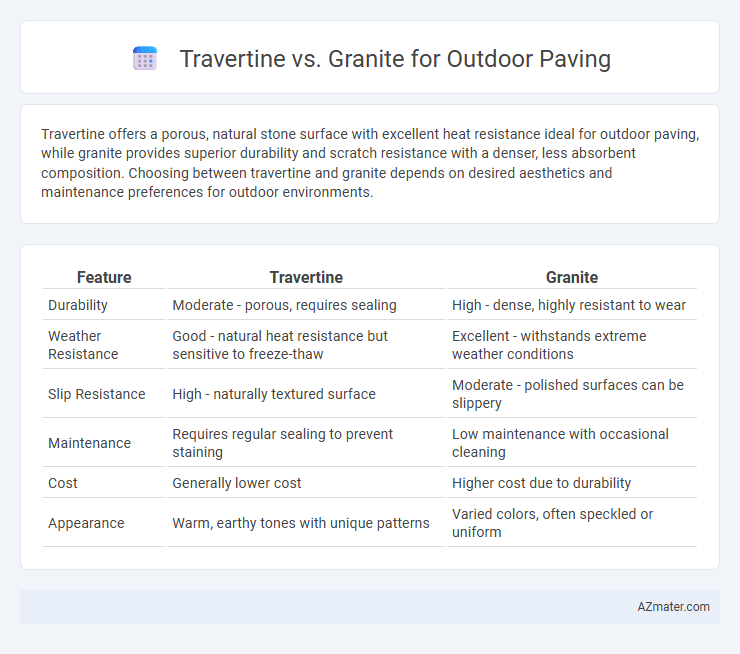Travertine offers a porous, natural stone surface with excellent heat resistance ideal for outdoor paving, while granite provides superior durability and scratch resistance with a denser, less absorbent composition. Choosing between travertine and granite depends on desired aesthetics and maintenance preferences for outdoor environments.
Table of Comparison
| Feature | Travertine | Granite |
|---|---|---|
| Durability | Moderate - porous, requires sealing | High - dense, highly resistant to wear |
| Weather Resistance | Good - natural heat resistance but sensitive to freeze-thaw | Excellent - withstands extreme weather conditions |
| Slip Resistance | High - naturally textured surface | Moderate - polished surfaces can be slippery |
| Maintenance | Requires regular sealing to prevent staining | Low maintenance with occasional cleaning |
| Cost | Generally lower cost | Higher cost due to durability |
| Appearance | Warm, earthy tones with unique patterns | Varied colors, often speckled or uniform |
Introduction: Travertine vs Granite for Outdoor Paving
Travertine and granite are popular choices for outdoor paving due to their durability and aesthetic appeal. Travertine offers a natural, porous texture with warm, earthy tones that resist heat, making it ideal for patios and pool surrounds. Granite provides exceptional strength and scratch resistance with a broad range of colors and grain patterns, suitable for high-traffic outdoor areas.
Aesthetic Appeal: Comparing Visual Characteristics
Travertine offers a naturally textured surface with warm earth tones and unique vein patterns that enhance outdoor spaces with rustic elegance. Granite features a polished, glossy finish with speckled granules in a wide range of colors, providing a sleek and modern aesthetic. The choice between travertine and granite depends on desired visual impact, with travertine emphasizing organic warmth and granite delivering a sophisticated, durable look.
Durability and Strength in Outdoor Applications
Travertine offers moderate durability with natural resistance to weathering but is more porous and softer compared to granite, making it prone to chipping and erosion under heavy outdoor use. Granite is significantly stronger and denser, providing exceptional resistance to scratches, impact, and harsh environmental conditions, which makes it ideal for high-traffic outdoor paving. For outdoor applications requiring long-term strength and minimal maintenance, granite outperforms travertine in durability and structural integrity.
Weather Resistance: Performance in Different Climates
Travertine exhibits excellent heat resistance, staying cool under direct sunlight, making it ideal for hot climates, but it is more porous and requires sealing to withstand heavy rain and freeze-thaw cycles compared to granite. Granite offers superior weather resistance with low porosity and high density, making it highly durable in wet, cold, and variable climates without much maintenance. Both materials resist UV fading, but granite's hardness provides better long-term performance against harsh weather extremes in outdoor paving applications.
Slip Resistance and Surface Safety
Travertine offers excellent slip resistance due to its naturally porous and textured surface, making it a safer choice for outdoor paving in wet conditions. Granite, while extremely durable and hard, can become slippery when polished, requiring a honed or flamed finish to improve traction. Prioritizing surface safety, travertine's inherent grip reduces the risk of slips, whereas granite demands specific treatments to ensure slip resistance in outdoor environments.
Maintenance Requirements and Longevity
Travertine offers a natural, porous surface that requires regular sealing to prevent staining and weather damage, maintaining its appearance over time. Granite, known for its density and hardness, demands minimal upkeep while providing exceptional resistance to scratches, freeze-thaw cycles, and harsh outdoor conditions. Both materials exhibit long-lasting durability, though granite generally outperforms travertine in longevity and low maintenance for outdoor paving projects.
Installation Process and Complexity
Travertine offers a simpler installation process for outdoor paving due to its lighter weight and consistent thickness, making it easier to cut and maneuver on-site compared to granite. Granite requires more specialized tools and expertise because of its hardness and density, increasing installation time and complexity. Proper substrate preparation is crucial for both materials to ensure durability, but granite's rigidity demands a more precise foundation to avoid cracking.
Cost Comparison and Value for Money
Travertine outdoor paving generally costs between $15 and $30 per square foot, offering a natural, elegant look with moderate durability suitable for patios and walkways, while granite ranges from $25 to $60 per square foot, boasting superior strength, weather resistance, and longevity. Although granite presents a higher upfront cost, its low maintenance and exceptional durability provide greater long-term value for high-traffic outdoor areas. Choosing travertine can be more budget-friendly initially, but granite delivers enhanced lifetime savings through reduced repair and replacement expenses.
Eco-Friendliness and Sustainability
Travertine and granite both offer durable options for outdoor paving, but travertine is often considered more eco-friendly due to its lower energy consumption during extraction and processing. Granite, while highly durable, requires more intensive quarrying that can result in greater environmental impact and carbon emissions. Choosing travertine supports sustainability with its natural porous composition that reduces heat retention, promoting cooler outdoor surfaces and minimizing urban heat island effects.
Conclusion: Which Stone is Best for Outdoor Paving?
Travertine offers a natural, slip-resistant surface that performs well in hot climates due to its heat-resistant properties, making it ideal for pool decks and patios. Granite provides superior durability and strength, resisting heavy foot traffic and harsh weather conditions, which suits high-traffic outdoor areas. Choosing between travertine and granite depends on the specific outdoor application, climate, and desired aesthetic, with travertine favored for comfort and appearance, while granite excels in longevity and toughness.

Infographic: Travertine vs Granite for Outdoor Paving
 azmater.com
azmater.com